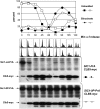Phosphorylation of the Sic1 inhibitor of B-type cyclins in Saccharomyces cerevisiae is not essential but contributes to cell cycle robustness
- PMID: 17483408
- PMCID: PMC1931548
- DOI: 10.1534/genetics.107.073494
Phosphorylation of the Sic1 inhibitor of B-type cyclins in Saccharomyces cerevisiae is not essential but contributes to cell cycle robustness
Abstract
In budding yeast, B-type cyclin (Clb)-dependent kinase activity is essential for S phase and mitosis. In newborn G(1) cells, Clb kinase accumulation is blocked, in part because of the Sic1 stoichiometric inhibitor. Previous results strongly suggested that G(1) cyclin-dependent Sic1 phosphorylation, and its consequent degradation, is essential for S phase. However, cells containing a precise endogenous gene replacement of SIC1 with SIC1-0P (all nine phosphorylation sites mutated) were fully viable. Unphosphorylatable Sic1 was abundant and nuclear throughout the cell cycle and effectively inhibited Clb kinase in vitro. SIC1-0P cells had a lengthened G(1) and increased G(1) cyclin transcriptional activation and variable delays in the budded part of the cell cycle. SIC1-0P was lethal when combined with deletion of CLB2, CLB3, or CLB5, the major B-type cyclins. Sic1 phosphorylation provides a sharp link between G(1) cyclin activation and Clb kinase activation, but failure of Sic1 phosphorylation and proteolysis imposes a variable cell cycle delay and extreme sensitivity to B-type cyclin dosage, rather than a lethal cell cycle block.
Figures











Similar articles
-
Sic1 plays a role in timing and oscillatory behaviour of B-type cyclins.Biotechnol Adv. 2012 Jan-Feb;30(1):108-30. doi: 10.1016/j.biotechadv.2011.09.004. Epub 2011 Sep 18. Biotechnol Adv. 2012. PMID: 21963604
-
Unraveling interactions of cell cycle-regulating proteins Sic1 and B-type cyclins in living yeast cells: a FLIM-FRET approach.FASEB J. 2012 Feb;26(2):546-54. doi: 10.1096/fj.11-192518. Epub 2011 Oct 14. FASEB J. 2012. PMID: 22002907
-
Sic1 as a timer of Clb cyclin waves in the yeast cell cycle--design principle of not just an inhibitor.FEBS J. 2012 Sep;279(18):3386-410. doi: 10.1111/j.1742-4658.2012.08542.x. Epub 2012 Mar 21. FEBS J. 2012. PMID: 22356687 Review.
-
The cyclin-dependent kinase inhibitor p40SIC1 imposes the requirement for Cln G1 cyclin function at Start.Proc Natl Acad Sci U S A. 1996 Jul 23;93(15):7772-6. doi: 10.1073/pnas.93.15.7772. Proc Natl Acad Sci U S A. 1996. PMID: 8755551 Free PMC article.
-
Phosphorylation and proteolysis: partners in the regulation of cell division in budding yeast.Curr Opin Genet Dev. 1997 Feb;7(1):7-16. doi: 10.1016/s0959-437x(97)80103-7. Curr Opin Genet Dev. 1997. PMID: 9024629 Review.
Cited by
-
Phosphate-activated cyclin-dependent kinase stabilizes G1 cyclin to trigger cell cycle entry.Mol Cell Biol. 2013 Apr;33(7):1273-84. doi: 10.1128/MCB.01556-12. Epub 2013 Jan 22. Mol Cell Biol. 2013. PMID: 23339867 Free PMC article.
-
Plasma membrane/cell wall perturbation activates a novel cell cycle checkpoint during G1 in Saccharomyces cerevisiae.Proc Natl Acad Sci U S A. 2016 Jun 21;113(25):6910-5. doi: 10.1073/pnas.1523824113. Epub 2016 Jun 7. Proc Natl Acad Sci U S A. 2016. PMID: 27274080 Free PMC article.
-
Clb3-centered regulations are recurrent across distinct parameter regions in minimal autonomous cell cycle oscillator designs.NPJ Syst Biol Appl. 2020 Apr 3;6(1):8. doi: 10.1038/s41540-020-0125-0. NPJ Syst Biol Appl. 2020. PMID: 32245958 Free PMC article.
-
Double-negative feedback between S-phase cyclin-CDK and CKI generates abruptness in the G1/S switch.Front Physiol. 2012 Dec 6;3:459. doi: 10.3389/fphys.2012.00459. eCollection 2012. Front Physiol. 2012. PMID: 23230424 Free PMC article.
-
Cyclin/Forkhead-mediated coordination of cyclin waves: an autonomous oscillator rationalizing the quantitative model of Cdk control for budding yeast.NPJ Syst Biol Appl. 2021 Dec 13;7(1):48. doi: 10.1038/s41540-021-00201-w. NPJ Syst Biol Appl. 2021. PMID: 34903735 Free PMC article. Review.
References
-
- Amon, A., M. Tyers, B. Futcher and K. Nasmyth, 1993. Mechanisms that help the yeast cell cycle clock tick: G2 cyclins transcriptionally activate G2 cyclins and repress G1 cyclins. Cell 74: 993–1007. - PubMed
-
- Bar-Even, A., J. Paulsson, N. Maheshri, M. Carmi, E. O'Shea et al., 2006. Noise in protein expression scales with natural protein abundance. Nat. Genet. 38: 636–643. - PubMed
-
- Bean, J. M., E. D. Siggia and F. R. Cross, 2006. Coherence and timing of cell cycle Start examined at single-cell resolution. Mol. Cell 21: 3–14. - PubMed
Publication types
MeSH terms
Substances
Grants and funding
LinkOut - more resources
Full Text Sources
Molecular Biology Databases
Research Materials

